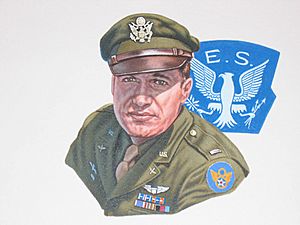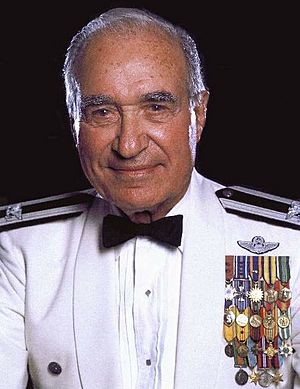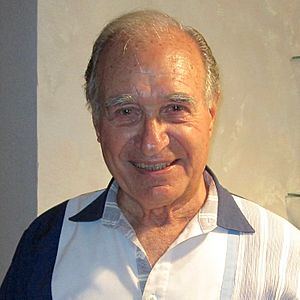Steve Pisanos facts for kids
Quick facts for kids
Steve Pisanos
|
|
|---|---|
 |
|
| Nickname(s) | The Flying Greek |
| Born | November 10, 1919 Metaxourgeio, Athens, Greece |
| Died | June 6, 2016 (aged 96) Rancho Bernardo, California, United States |
| Allegiance | United Kingdom United States |
| Service/ |
Royal Air Force (1940–42) United States Army Air Forces (1942–47) United States Air Force (1947–74) |
| Years of service | 1940–1974 |
| Rank | Colonel |
| Unit | 4th Fighter Group No. 71 Squadron RAF |
| Battles/wars | World War II Vietnam War |
| Awards | Legion of Merit (3) Distinguished Flying Cross (5) Purple Heart Air Medal (11) Air Force Commendation Medal Army Commendation Medal |
| Other work | Author |
Steve Pisanos was a brave Greek-American pilot. He was born Spiros Pisanos on November 10, 1919, and passed away on June 6, 2016. He became a "flying ace" during World War II, meaning he shot down many enemy planes. Steve flew for both the British Royal Air Force (RAF) and later the United States Army Air Forces.
He was known for shooting down 10 enemy aircraft while flying with the American 4th Fighter Group. After the war, he became a colonel in the United States Air Force. He also flew in the Vietnam War. By the time he retired in 1974, he had earned 33 awards for his service. Steve Pisanos wrote a book about his life called The Flying Greek, which came out in 2008.
Contents
Early Life and Dreams
Steve Pisanos was born in Metaxourgeio, Athens, Greece. His father was a railroad engineer. When Steve was a young boy, he saw a Greek biplane flying overhead. This made him dream of becoming a pilot.
He often visited a military airfield called Dekelia (Tatoi) near Athens. The people working there got to know him. They even let him explore the hangars and sit in the planes! After finishing school, he wanted to go to the United States. He knew he could take private flying lessons there. In 1938, he got a job as a merchant seaman. When his ship reached Baltimore, he left it and went to New York. He started working there as an immigrant without papers.
Flying for the Royal Air Force
Steve arrived in the U.S. with very little money. He worked in a bakery and then as a tray boy in Plainfield, New Jersey. He spent most of his earnings on English and flying lessons. In 1939, he finally earned his private pilot's license. Because he was well-liked, he was able to become a legal immigrant worker in the United States. People started calling him 'Steve' for short, and this name stuck.
When World War II began and Greece was attacked in 1940, Steve tried to join the United States Army Air Forces. But the U.S. was not yet in the war, so he was turned down. However, the Royal Air Force (RAF) in Britain was looking for pilots. Since Britain was an ally of Greece, they accepted him.
Steve was chosen as a pilot candidate for the RAF after tests in California. He trained in Canada and England. Then, he joined No. 71 Squadron RAF, which was an "Eagle Squadron" made up of American pilots. He was still a Greek citizen at this time. He mostly flew the Spitfire Vb on missions over Europe. He was a very popular pilot within his group.
Joining the U.S. Army Air Forces
Steve Pisanos was not an American citizen, so he couldn't join a fully American combat unit. The Greek government also wanted him to join one of their new squadrons. But Steve's friends wanted him to stay with them. They helped convince the U.S. government to make him an American citizen. This happened on May 3, 1942, with help from his commander. Steve Pisanos became the first American citizen to be naturalized while serving in another country.
When the United States joined World War II, they started building air bases in England. The pilots in the three 'Eagle Squadrons' were the only American pilots in Europe with combat experience. So, the U.S. Army Air Forces decided to bring them into their ranks. The pilots wanted to stay together. So, Steve's unit, No. 71 Squadron RAF, became the 334th Fighter Squadron in September 1942. This squadron was part of the new 4th Fighter Group.
In March 1943, the 4th Fighter Group started flying the new P-47 Thunderbolt fighter. Steve's plane had an emblem of 'Miss Plainfield' painted on it. He got his first two confirmed victories over Belgium while protecting U.S. bombers. He was soon promoted to Flight Lieutenant. He flew many more missions over France, shooting down four more enemy planes. People back in New Jersey heard about his successes. The local newspaper wrote an article about him called 'The Flying Greek'. This name later inspired the title of his book.
By the end of 1943, Steve Pisanos had six confirmed air victories. In January 1944, the 4th Fighter Group received the new P-51 Mustang fighter. On March 5, 1944, during a mission over southern France, he shot down two more enemy planes. On his way back, his plane had engine trouble, and he had to land in France. He was later helped by the French Resistance.
Helping the French Resistance
The French Resistance helped Steve Pisanos hide from the Germans. They gave him a false identity so he could try to escape through Spain. But instead, he stayed with the French Resistance. He moved to Paris and worked with agents to gather information about German movements. He also took part in local fights until Paris was freed.
Most American pilots who were shot down and avoided capture were sent back to the U.S. This was to prevent them from being captured again and possibly revealing information about the French helpers. After Steve returned to the U.S., he was given the job of test-flying captured enemy aircraft. This helped the U.S. understand their performance.
Career in the United States Air Force
After World War II, Steve Pisanos flew the first U.S. jet fighter, the P-80 Shooting Star. He briefly worked as a commercial pilot. But because of his experience flying jets, he returned to the United States Air Force as a Captain.
Steve attended the USAF Flight Performance School, which is now the U.S. Air Force Test Pilot School. He became a Major and was tasked with testing advanced jet fighters, like the F-102 Delta Dagger. He often flew these planes at very high speeds, faster than the speed of sound, and at very high altitudes. He continued to serve, testing new weapons. He also served in Vietnam. Near the end of his career, as a Colonel, he helped the Hellenic Air Force (Greece's air force) get the F-4E Phantom II jet fighter. In 1974, he retired from the Air Force. He lived in San Diego, California, with his wife, Sofia.
Later Life and Legacy
In 2008, Steve Pisanos was honored by being added to the International Air & Space Hall of Fame at the San Diego Air & Space Museum. In 2010, he received the French Legion of Honor. This is France's highest award. He received it for his amazing achievements in World War II as a fighter pilot and for helping the French Resistance.
Steve Pisanos passed away on June 6, 2016, at his home in Rancho Bernardo, San Diego, California. He was 96 years old. His wife, Sofia, had passed away in 2012. He is buried next to her at the Miramar National Cemetery in San Diego.



